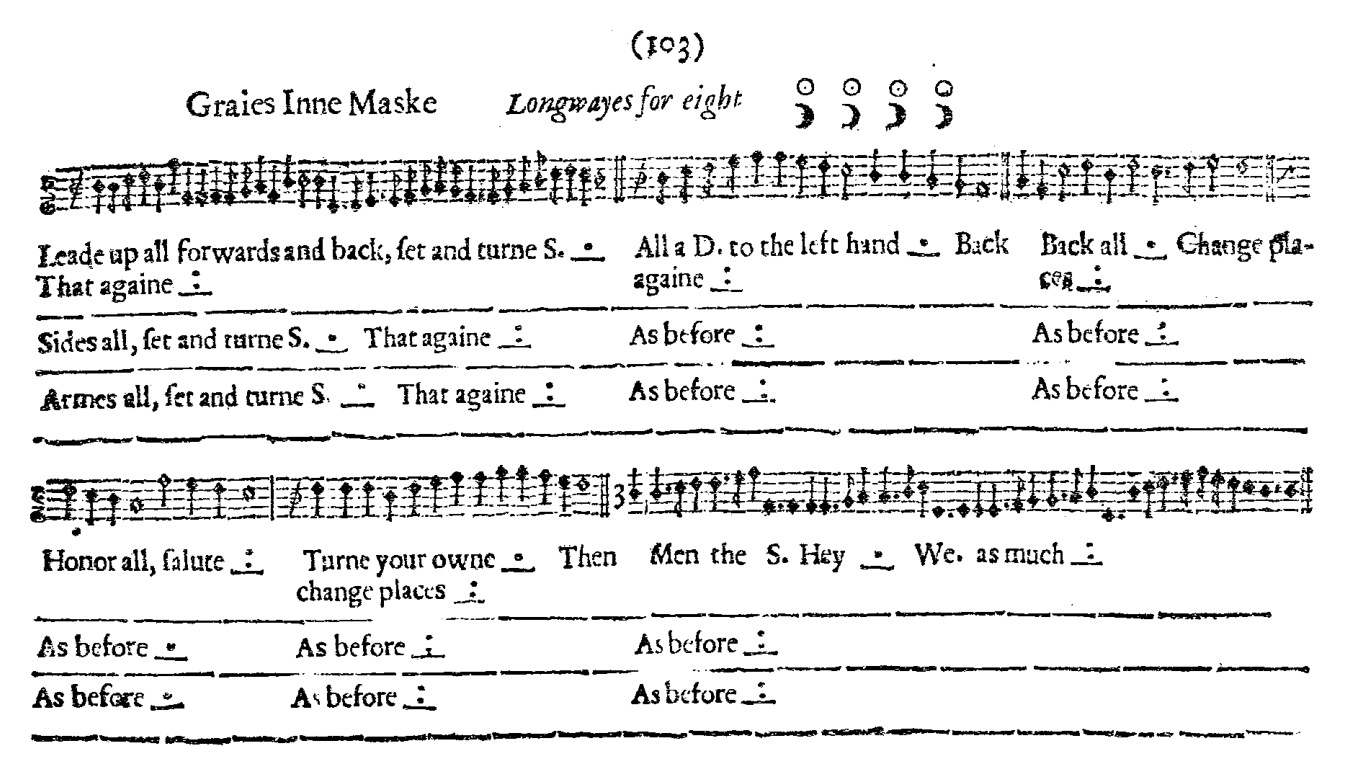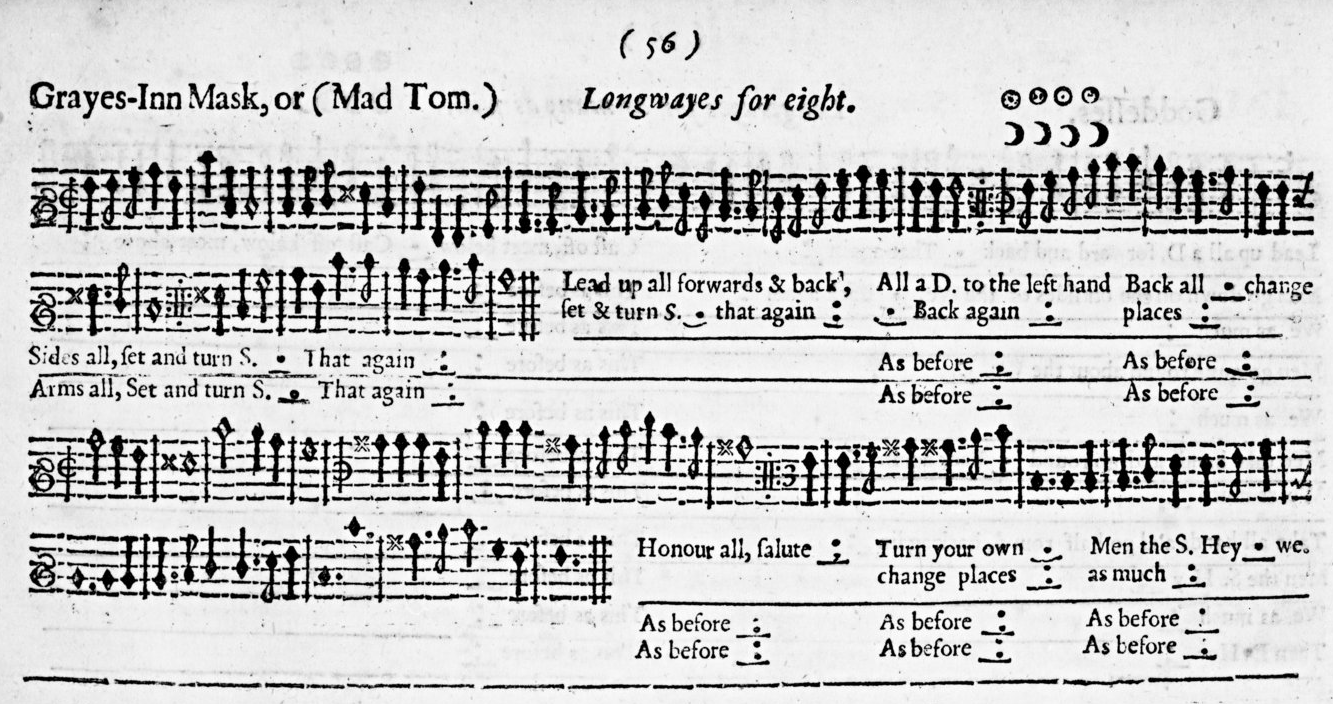This dance is in Playford (first edition) and Lovelace.
Gray's Inn is one of the four Inns of Court (London law schools) to whom the Dancing Master was dedicated by Playford.
A Masque was a form of courtly entertainment. This is not a social dance, it's all for show, and you should show not be inhibited about showing off while dancing it!
Playford (4 couple longways):
| Part 1 | |
|---|---|
| A1 (8) | Lead up a double and back (4) Set and turn single left (4) |
| A2 (8) | Lead up a double and back (4) Set and turn single right (4) |
| B1 (4) | Lines face their respective left and go forwards and back in single file Alternative: Take hands in lines and slip left and right |
| B2 (4) | Same to the right |
| C1 (4) | Lines fall back a double and advance |
| C2 (4) | Lines change places |
| D1 (4) | Men set right and left to partner |
| D2 (4) | Women set right and left to partner |
| E1 (4) | Two-hand turn with exuberance (can be twice if you fancy) |
| E2 (4) | Long change places |
| F1 (8) | Men hey |
| F2 (8) | Women hey |
| Part 2 | |
| A1 (8) | Side right (4) Set and turn single left (4) |
| A2 (8) | Side left (4) Set and turn single right (4) |
| The rest as part 1 | |
| Part 3 | |
| A1 (8) | Arm right (4) Set and turn single left (4) |
| A2 (8) | Arm left (4) Set and turn single right (4) |
| The rest as part 1 | |
Lovelace (~3 couple longways):
| Part 1 | |
|---|---|
| A1 (8) | Lead up a double and back (4) 1C cast to the bottom, others following, to invert the set (4) |
| A2 (8) | Lead down a double and back (4) 1C cast back up, others following, to original set (4) |
| B1 (4) | 2 hand turn your partner just ¼ in a double to face up and down in lines, then back |
| B2 (4) | Same in the other direction |
| C1 (4) | Men set and turn single left to women |
| C2 (4) | Women set and turn single left to men |
| D1 (4) | Men honour right and left to partner |
| D2 (4) | Women honour right and left to partner |
| E1 (4) | Two-hand turn with exuberance |
| E2 (4) | Two-hand turn the other way |
| F1 (8) | Lines fall back a double (2) People at the top go down the middle, up the outside, and down the middle again, everyone else following, to invert the set (6) |
| F2 (8) | Repeat F1 home, 1C leading again coming up from the bottom |
| Part 2 | |
| As part 1 with siding, and the women going first in phrases C and D | |
| Part 3 | |
| As part 1 with arming | |
| Parts 4-6 (optional) | |
| Repeat the whole dance except: | |
| C1 (4) | All set and turn single left to partner |
| C2 (4) | All set and turn single right to partner |
| D1 (4) | All honour right and left to partner |
| D2 (4) | All honour right and left even more flamboyantly |
| For the extremely committed | |
| 1C to the bottom and repeat the whole dance for each couple | |
T:Gray's Inn Mask
M:2/2
L:1/4
Q:"Steady"
K:Ddor
P:A
"Dm"dd/e/fd|"Am"aAA2|"A"AA/B/^cA|"Dm"dDD>E|
"F"F>F "Gm"G>G|"Am"A/B/c/B/A>A|"G"B/c/d/e/ "A"fe|"Dm"d4:|
Q:"Faster"
P:B
|:"Dm"d/e/f/g/aa|"C"gfe>f|"G"dd^c>B|"A"A4:|
P:C
|:"A"^cAe2|"Dm"fda>a|"C"gfg>a|"F"f4:|
P:D
Q:"Slow"
|:"Dm"f2ed|"Am"c4|"F"a2gf|"C"e4:|
P:E
Q:"Faster"
|:"D"^fffd|aaa^f|"G"g/a/b "A"a>g|1"D"^f4:|2[M:6/8]"D"^f3-f2d||
L:1/8
P:F
|:"D"d>e^f f>ga|"Am"A3 A2A|"Am"A>Bc c>de|"G"G3 G2G|
"G"G>AB B>cd|"A"A3 a3|"D"^f>ga "A"e2d|"D"d6:|
X:40
T:Gray's Inn Mask
T:(conventional accidentals)
M:2/2
L:1/4
Q:"Steady"
K:Ddor
P:A
"Dm"dd/e/fd|"Am"aAA2|"Am"AA/B/cA|"Dm"dDD>E|
"F"F>F "Gm"G>G|"Am"A/B/c/B/A>A|"G"B/c/d/e/ "Am"fe|"Dm"d4:|
Q:"Faster"
P:B
|:"Dm"d/e/f/g/aa|"C"gfe2|"G"ddcB|"Am"A4:|
P:C
|:"Am"cAe2|"Dm"fdf2|"C"e>fg2|"F"f4:|
P:D
Q:"Slow"
|:"Dm"f2ed|"Am"c4|"F"a2gf|"C"e4:|
P:E
Q:"Faster"
|:"D"^fffd|fgaa|"G"bb "A"ag|1"D"^f4:|2[M:6/8]"D"^f3-f2d||
L:1/8
P:F
|:"D"d>ef f>ga|"Am"A3 A2A|"Am"A>Bc c>de|"G"G3 G2G|
"G"G>AB B>cd|"F"F3 "D"d2e|"D"f>ga/g/ "Am"fe2|"D"d6:|
Sources
First edition Playford:

Fourth edition Playford:

Lovelace:
16. Tom a Bedlam, or Grayes Inn Maske, (Grays=Inne Maske) for 2, or more
Leade up once, and downe agayne, and then cast of all, downe to the other end and then leade up all agayne that way, and downe againe all into your places;
The men shall take each his woeman, by both hands, and set them all in a straight line, the man standing all above the woeman, and then backe into their places againe, like as they stood at first All the woemen shall stand still, and all the men shall sett each to his woeman, and then they standing still the woemen shall set to them;
All the men shall congee each to to his woeman, and salute her she standing still, and then the woemen shall do the like unto him;
The men shall turn each his woemen once forward, and once backward;
Both men and woemen shall fall of backewards, and leade round three times before they come to the bottome, and the same back againe, till they come to the toppe after the same maner all in your places;
Sides all once at the top, and then fall downe, and sides all at the end, and then fall backe unto your places, and then doe all the same over gayne, only what, the men did first soe fore the woemen shall doe itt first now, like as the man dide sett first before, the woemen shall now first, and then the woeman salute first before the man, and soe all the same, only the woemen shall doe first that which the man did before;
Armes all once at the top, and once att the bottome, like before at leading up and all setting, then doe the first over againe, only the men and woemen shall salute this time both together, and as they did sett before singly, they shall now sett both men, and woemen together, and after they shall have done all those six parts, after siding, and turning, they may leade downe, and if they please the rest may doe the like, every couple of them;
Music
Notice in the originals that there are three different time signatures here:
A C with a line through it, this is split common time, i.e. 2 beats to the bar. It's 2/2 in modern notation.
A backwards C with a line through it, this denotes the same time signature, but faster.
A 3, this denotes compound time, 6/4 in modern notation. These days we tend to write this out as 6/8 instead so you can group the quavers by bar lines.
These different speed indications tell you about the drama of the dance.
Also note the difference between first edition and fourth edition. Most of those changes happened by second edition. The main changes are a lot of additional accidentals and notes on ledger lines. Jeremy Barlow (who wrote the book on Playford's music) has a great paper theorizing that Playford ran out of sharps and ledger lines in first edition, which were subsequently corrected. It looks likely that that might be what's happened here. The version of the music most people know is the version from first edition so I've included that but first I've included the version that was published for most of the time this was being published, which is somewhat different!
The final problem is the repeats. The music notation normally doesn't help us here, you have to work it out from the phrase marks in the dance notation. Here there are : marks on every phrase, indicating each one is repeated. The evidence is far from emphatic – there aren't double bar lines on each phrase in the music, and while not every phrase is repeated, the double bar lines and phrase marks in the dance notation do usually line up. In the relevant bits of the Lovelace description, it tends to describe enough instructions for repeats in all these places, so I've gone for maximal repeats in general, leading to maximum opportunity for showing off and befitting the drama of the dance. If you interpret it differently, you have some justification!
Playford
It starts fairly harmlessly. The second figure, where the speed picks up, I interpret as lines going to their individual left – see "the left/right hand" in my interpretation guidelines. That said, it's quite common to take hands in lines and slip left and right instead, which is fun and fits the change of pace, and I frequently do just because people like doing it!
For Back all I have back a double and forwards again, copying what's clear in the Merry Merry Milkmaids, and using up the musical phrase indicated by · . You change places in the second phrase, giving lots of time to show off.
Honour is fairly standard; salute doesn't mean what we mean today, it's a salutation i.e. greeting, such as a kiss on the hand. That's less acceptable today so I tend to suggest a bow stepping to the right and then another stepping to the left. It says : and I'm giving a repeat so I do it for the men's side and then the women's side. This matches what Lovelace says in the same part.
The music picks up speed again with a 2-hand turn and a separate phrase for a change places. Again Lovelace says both ways, reinforcing that there are two separate phrases here. The heys are straightforwards enough.
Lovelace
This is described as "for 2 or more", but I tend to do for 3 couples as that's what I find works best for the last couple.
The first figure starts with a conundrum. After the lead up and back, everyone casts off, then leads up, then casts off again. How is this to fit to the music? Note that this is for an unspecified number of couples, with a minimum of 1. It's possible that simply this is designed for any number, with music expected to change to fit. I've kept the music the same as the Playford version but longer sets as 1 couple at a time would be a bit unusual, and just cast once, but you could extend that if you want.
The second figure is a bit unusual but feels reasonably good to dance. Later, congee means honour. The meaning of the final figure is far from obvious but the formula I've got seems to work quite well.
The men go first, then the women, then the men, which is nice. The whole dance is then repeated with the men and women going together. And then, if that's not enough of a good thing, there's the option for the top couple to go to the bottom and repeat all of that for every couple. You're getting your money's worth for this one!